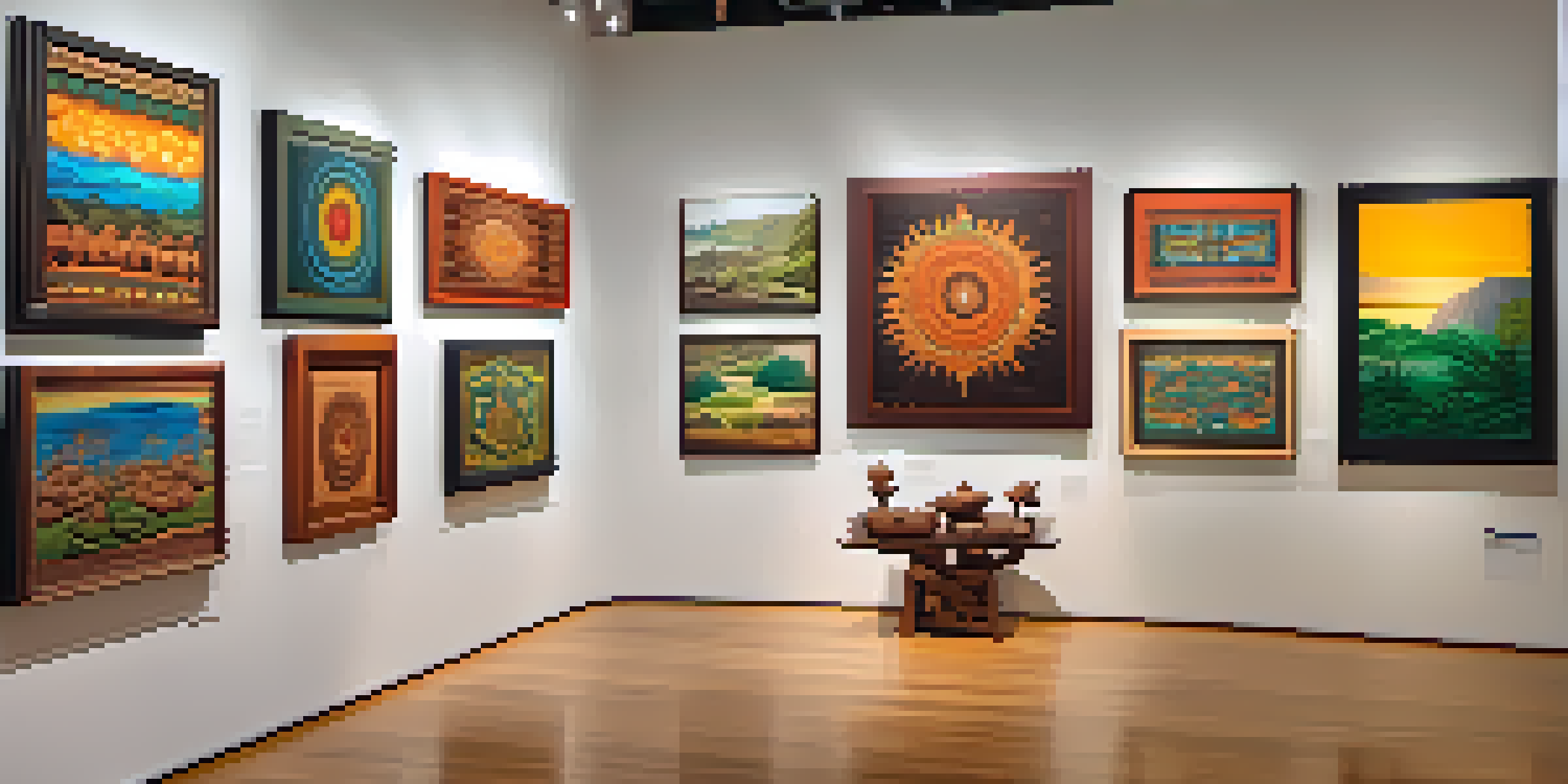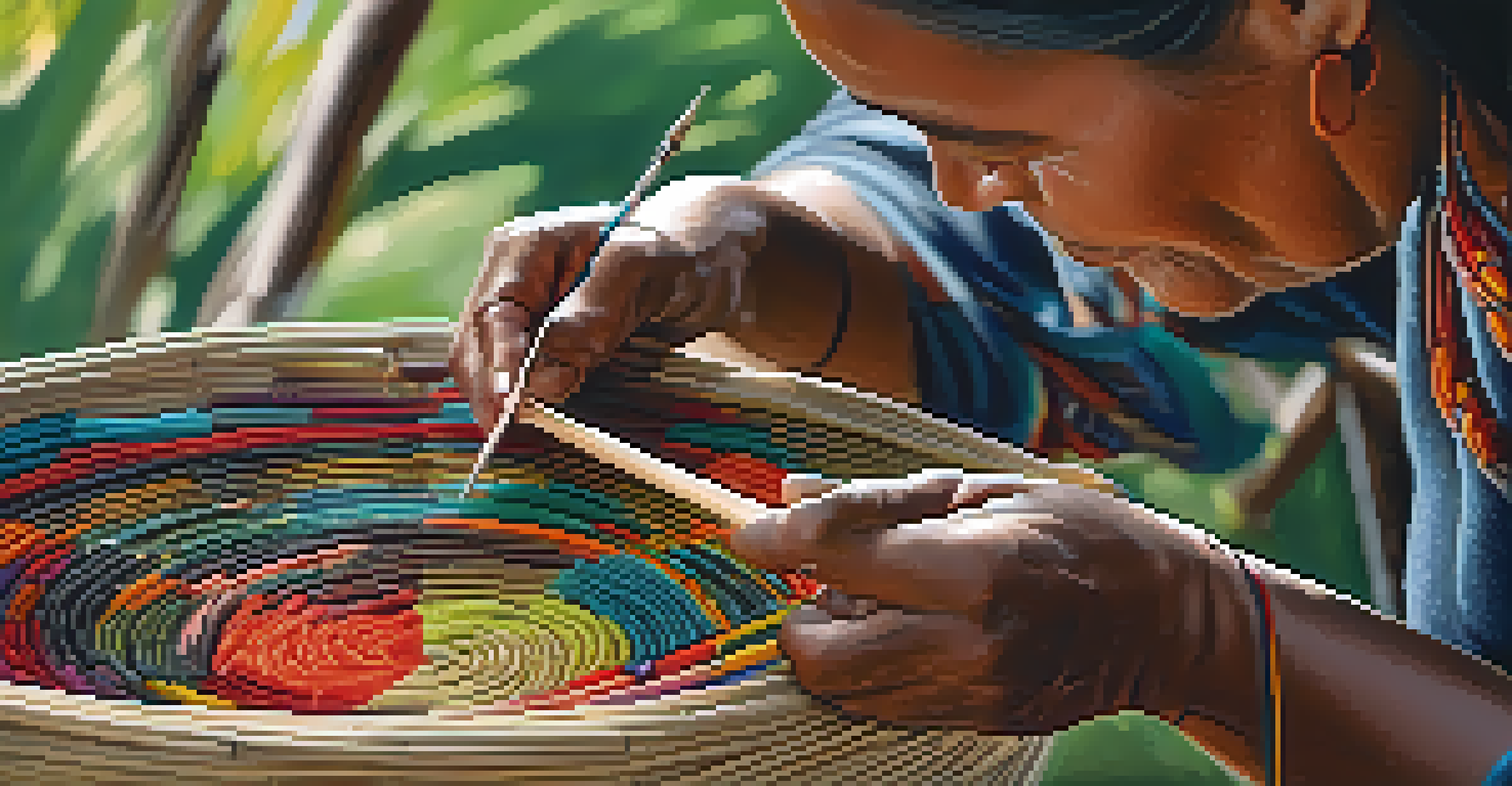Exploring Indigenous Art: A Cultural Journey

Understanding the Roots of Indigenous Art
Indigenous art is deeply intertwined with the history and culture of Indigenous peoples. Each piece reflects their unique stories, traditions, and beliefs that have been passed down through generations. By exploring these roots, we gain insight into the lived experiences and worldviews of these communities.
Art is the most beautiful of all lies; it allows us to see the truth of our existence.
Art serves as a vital form of expression, embodying the spirituality and connection to the land that Indigenous peoples hold dear. From carvings to paintings, every artwork tells a story that resonates with cultural significance. This connection to nature and ancestry is a recurring theme that enriches the understanding of Indigenous art.
As we delve deeper, it's essential to recognize that Indigenous art is not just a genre but a vibrant and evolving practice. Artists often blend traditional methods with contemporary techniques, creating a dynamic and diverse portfolio that speaks to both heritage and modernity.
The Significance of Symbols in Indigenous Art
Symbols play a crucial role in Indigenous art, often representing various elements of life, nature, and spirituality. These symbols can vary greatly among different Indigenous cultures, each with its own meanings and interpretations. For instance, the spiral may symbolize growth and evolution in some cultures, while in others, it may represent the journey of life.

Understanding these symbols adds depth to our appreciation of Indigenous artworks. They are not merely decorative but serve as vessels of knowledge and cultural identity, conveying stories and teachings that are essential to Indigenous communities. When we look beyond the surface, we discover a rich tapestry of meaning woven into each piece.
Indigenous Art Reflects Cultural Heritage
Indigenous art embodies the unique stories, traditions, and beliefs of Indigenous peoples, offering insights into their lived experiences.
Moreover, the use of symbols fosters a sense of connection between the artist and the viewer. It invites us to engage in a dialogue, encouraging us to explore the narratives behind the artwork and reflect on our own experiences and beliefs.
Traditional Techniques and Materials in Indigenous Art
The creation of Indigenous art often involves traditional techniques and materials that have been used for centuries. Artists may utilize natural pigments, wood, clay, and other resources sourced from their environment. This closeness to nature not only highlights sustainability but also showcases a profound respect for the land.
Art enables us to find ourselves and lose ourselves at the same time.
Each technique carries its own significance, whether it's weaving, carving, or painting. For instance, the intricate patterns found in basket weaving tell stories of community and survival. By learning about these methods, we can appreciate the skill and dedication that goes into each piece of art.
As Indigenous artists continue to innovate, they often blend these traditional techniques with contemporary styles. This fusion not only preserves cultural heritage but also allows artists to express their identities in new and exciting ways, bridging the gap between past and present.
Modern Indigenous Artists Making Waves Today
In recent years, a new generation of Indigenous artists has emerged, gaining recognition on national and international stages. These artists are not only preserving their heritage but also challenging perceptions and stereotypes through their work. By addressing contemporary issues, they bring urgent conversations to light, engaging audiences in meaningful ways.
Take, for example, artists like Lisa Reihana, whose multimedia installations explore themes of colonization and identity. Such works invite viewers to reconsider historical narratives and their implications on present realities. The creativity and boldness of these modern artists demonstrate the evolving nature of Indigenous art.
Symbols Convey Deep Meanings
Symbols in Indigenous art represent essential elements of life and spirituality, inviting viewers to engage in meaningful dialogues about cultural identity.
Furthermore, their success paves the way for future generations, inspiring young Indigenous people to explore their artistic potential. This revival is vital, as it ensures that Indigenous stories and perspectives continue to thrive in a diverse cultural landscape.
The Role of Art in Cultural Preservation
Art plays a significant role in the preservation of Indigenous cultures and languages. Through storytelling, visual art, and performances, Indigenous artists keep their traditions alive, passing knowledge and values to younger generations. This practice not only strengthens cultural identity but also fosters community resilience.
Moreover, the resurgence of interest in Indigenous art has sparked a broader conversation about cultural appropriation and respect. It encourages both Indigenous and non-Indigenous people to engage in meaningful dialogue about the importance of authenticity and representation in art. This awareness is crucial for creating a more inclusive cultural environment.
By supporting Indigenous artists and their work, we contribute to the preservation of their cultural heritage. This not only benefits Indigenous communities but enriches our shared human experience, reminding us of the power of art to connect us all.
Art Exhibitions: Showcasing Indigenous Talent
Art exhibitions dedicated to Indigenous artists provide a vital platform to showcase their talent and creativity. These events allow the public to engage with Indigenous art in a meaningful way, fostering a greater understanding of the cultural context behind each piece. From local galleries to major institutions, these exhibitions are essential for elevating Indigenous voices.
One shining example is the Biennale of Sydney, which has featured numerous Indigenous artists over the years. Such platforms not only celebrate artistic accomplishments but also challenge the art world to diversify its narratives. By highlighting Indigenous perspectives, these exhibitions contribute to a richer, more inclusive understanding of art.
Modern Artists Redefine Indigenous Art
A new generation of Indigenous artists is challenging stereotypes and addressing contemporary issues, ensuring the relevance and evolution of their cultural narratives.
Furthermore, these showcases often include educational programs and workshops, inviting audiences to learn directly from Indigenous artists. This hands-on approach fosters appreciation and respect for the art form, ensuring that the stories behind the art are not lost.
Engaging with Indigenous Art: A Personal Journey
Exploring Indigenous art can be a deeply personal journey for many. It encourages us to reflect on our own identities, beliefs, and connections to the cultures around us. By engaging with Indigenous art, we open ourselves up to new perspectives and experiences that enrich our understanding of the world.
Visiting galleries, attending workshops, or simply taking the time to learn about Indigenous artists can be rewarding. Each interaction provides an opportunity for growth, allowing us to appreciate the beauty and complexity of Indigenous cultures. This journey can also lead to meaningful conversations about respect, representation, and cultural exchange.

Ultimately, the exploration of Indigenous art is not just about appreciation but also about fostering connections. It reminds us of our shared humanity and the importance of honoring diverse cultures as we navigate our increasingly interconnected world.